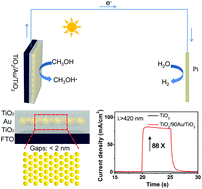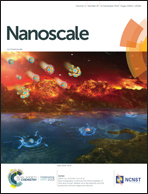Plasmonic nanoparticle-film-assisted photoelectrochemical catalysis across the entire visible-NIR region†
Abstract
Low solar light absorption and high electron–hole pair recombination are still the main challenges for solar energy conversion. Here, we design a plasmonic nanoparticle (NP)-film with a unique structure combining the advantages of a Au NP and film, which exhibits strong broadband absorption from the visible to near-infrared (NIR) wavelength range. In addition, the high density of sub-1 nm inter-particle gaps in the Au NP-film supports electromagnetic field enhancement of several orders of magnitude that greatly promotes the generation and separation of electron–hole pairs. Accordingly, the plasmonic NP-film-assisted photocatalyst (TiO2/90Au/TiO2) leads to an 88-fold increase in the photocurrent density at 0.75 V vs. RHE in 25% methanol solution under visible-NIR light irradiation (λ > 420 nm) compared to a TiO2 film, which is higher than those of the ever reported Au/TiO2 photocatalysts in the entire visible-NIR range. Our finding indicates a promising way to explore full solar spectrum photocatalysts, which can be easily extended to other energy conversion applications.



 Please wait while we load your content...
Please wait while we load your content...